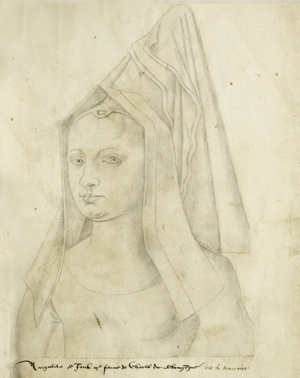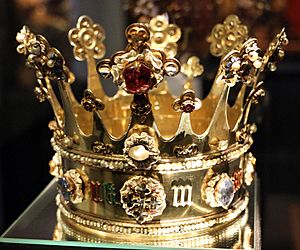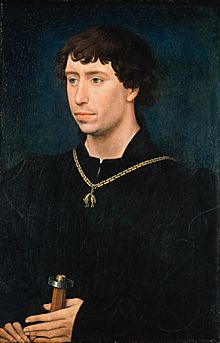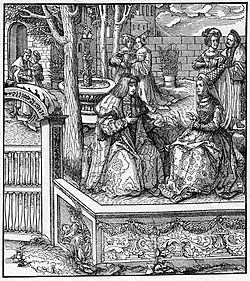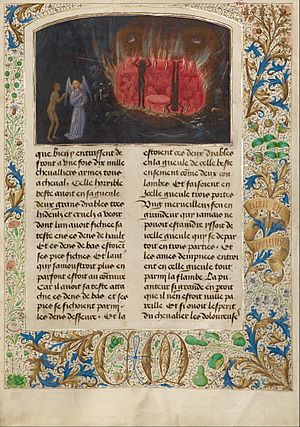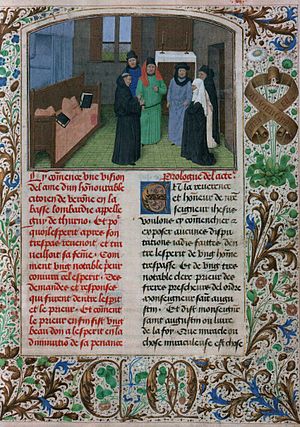Margaret of York facts for kids
Quick facts for kids Margaret of York |
|
|---|---|
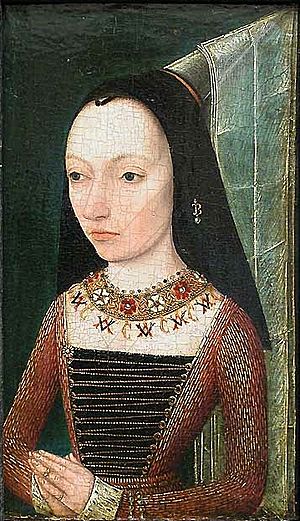
Portrait by anonymous painter, ca. 1468
|
|
| Duchess consort of Burgundy | |
| Tenure | 9 July 1468 – 5 January 1477 |
| Born | 3 May 1446 Fotheringhay Castle, Northamptonshire, England |
| Died | 23 November 1503 (aged 57) Mechelen, Flanders |
| Spouse | |
| House | York |
| Father | Richard Plantagenet, 3rd Duke of York |
| Mother | Cecily Neville |
| Religion | Roman Catholicism |
Margaret of York (born May 3, 1446 – died November 23, 1503) was an important figure in European history. She was also known as Margaret of Burgundy after her marriage. She became the Duchess of Burgundy as the third wife of Charles the Bold. After Charles died, she helped protect the Burgundian State. Margaret was the daughter of Richard, 3rd Duke of York, and Cecily Neville. She was also the sister of two English kings, Edward IV and Richard III. She was born in Fotheringhay Castle, England, and passed away in Mechelen, in what is now Belgium.
Contents
Growing Up in England
Margaret grew up during a time of great change in England. Her family, the House of York, was fighting for control of the country against another powerful family, the House of Lancaster. This conflict was known as the Wars of the Roses.
The Duchess of Burgundy, Isabella, was Charles the Bold's mother. She was very interested in England because of family ties and trade. She wanted Burgundy to have good relations with England to keep their trade strong. By 1454, Isabella supported Margaret's father, Richard, Duke of York.
At this time, Margaret was only 8 years old. Her father was in power for a short time. Negotiations began for Margaret to marry Charles the Bold, who was then called the Count of Charolais. However, these talks stopped because of problems in England. Also, Charles's father, Philip the Good, preferred an alliance with France. Charles later married Isabella of Bourbon in 1454.
A New Chance for Marriage
Margaret was still unmarried at 19. Charles's first wife, Isabella of Bourbon, died in 1465. She had only one daughter, Mary. Charles needed a son to continue his family line.
By this time, Margaret's family was much stronger. Her father had died, but her brother, Edward IV, was now the King of England. Charles the Bold was also very powerful in Burgundy. He wanted to marry an English princess to form an alliance against France.
So, Charles sent his advisor to England to propose marriage to Margaret. King Edward IV liked the idea. In 1466, Edward sent his brother-in-law, Lord Scales, to Burgundy. Lord Scales formally offered Margaret's hand in marriage to Charles.
A Royal Wedding
The marriage did not happen right away. There were more talks needed. Also, the King of France, Louis XI, did not want England and Burgundy to become allies. He tried to stop the marriage by offering other marriage proposals to Margaret and her brothers.
In 1466, Margaret was briefly engaged to Peter, Constable of Portugal. He was a nephew of Charles's mother, Isabella. But Peter died soon after, leaving Margaret available again.
By 1467, things had changed once more. Charles's father, Philip the Good, had died. Charles the Bold was now the Duke of Burgundy. King Edward IV of England faced new challenges from his enemies. He needed Charles's support. So, Edward officially agreed to the marriage in October 1467.
Louis XI of France tried everything to prevent the wedding. He asked the Pope to refuse permission for the marriage because Margaret and Charles were distant cousins. He also tried to stop England from getting money for Margaret's dowry (money or property a bride brings to a marriage). But his efforts failed.
A detailed agreement was made between England and Burgundy. It covered defense, trade, and travel. Margaret kept her rights to the English throne. Her dowry was promised to Burgundy even if she died early. Charles gave Margaret the cities of Mechelen, Oudenaarde, and Dendermonde as her own.
The Journey and Ceremony
Margaret left England on June 23, 1468. Her journey across the sea was safe, even though Louis XI had ordered his ships to try and capture her. She arrived in Sluys on June 25.
The next day, she met Charles's mother, Isabella, and his daughter, Mary. They all got along very well and remained close friends. On June 27, Margaret met Charles for the first time. They were privately married early in the morning on July 3, in Damme.
The celebrations that followed were incredibly grand. Margaret entered Bruges in a golden carriage pulled by white horses. She wore a beautiful crown. She waved to the people, which charmed them. The city was decorated with torches and flowers. Wine flowed freely from statues. The coats of arms of Charles and Margaret were everywhere. The celebrations also included a special tournament called the "Tournament of the Golden Tree."
Margaret's Crown
At the wedding, both the Duke and Duchess wore magnificent crowns. Margaret's crown was decorated with pearls and white roses, which were the symbol of her family, the House of York. It also had her name, "Margarita de York," spelled out in letters.
This crown was probably too small to fit directly on her head. It might have been worn over a tall, pointed hat called a hennin. Margaret later gave this crown to the Church of Our Lady in Aachen in 1475. Today, the statue of the Virgin Mary in Aachen Cathedral wears this crown on special days.
This crown is very important because it survived the later English Civil War. During that war, most of England's royal jewels were destroyed. Margaret's crown is one of only two medieval British royal crowns still existing today.
Duchess of Burgundy
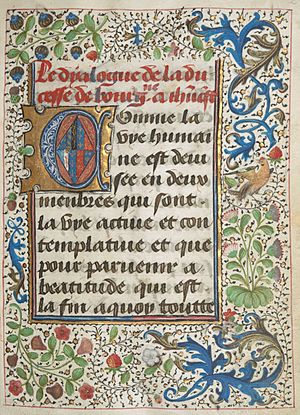
Even though Margaret and Charles did not have children, Margaret was very valuable to Burgundy. After her wedding, she traveled with her step-daughter Mary. They visited many towns in Flanders, Brabant, and Hainaut. People were impressed by Margaret's intelligence and ability.
Margaret's family connections were also important. In 1469, her brother, King Edward IV, tried to give Charles the Order of the Garter. This was a high honor, but accepting it would have made Charles seem disloyal to the King of France. Charles refused the offer.
In 1469, Edward IV temporarily lost his power in England. Charles helped his brother-in-law by threatening London merchants. This helped Edward regain his throne. But in 1470, Margaret was upset when Edward was overthrown again. She tried to help her brothers, Edward and George, make peace.
When Edward IV had to flee England, he came to Margaret and Charles in Burgundy. Margaret strongly urged her husband to help Edward get his throne back. Charles eventually agreed, as it was also in Burgundy's best interest to oppose the French-backed Lancastrian rule in England.
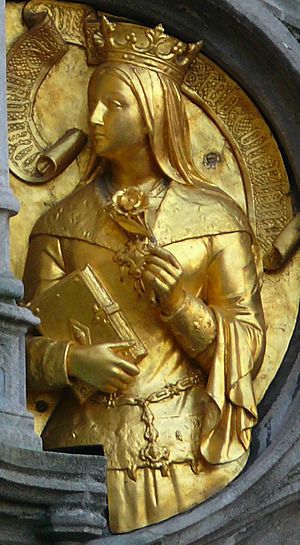
By April 1471, Edward was back in England. Margaret followed the events closely. She was happy when her brothers, George and Edward, made up. Edward IV successfully got his throne back. The main line of the House of Lancaster ended with the deaths of Henry VI and his son.
Margaret's mother-in-law, Isabella, gave her favorite home, La-Motte-au-Bois, to Margaret in her will. However, Isabella and Charles also made a claim to the English throne through Isabella's family ties to the House of Lancaster. Charles chose not to press this claim, as he found it more useful to support Edward IV.
By 1477, Margaret's position as Duchess was not as strong. Charles the Bold had become very ambitious. He dreamed of creating a new kingdom. This led him to fight many wars with his neighbors, who then allied against him. Louis XI of France also worked to weaken Burgundy.
In 1476, Charles arranged for his daughter, Mary, to marry Maximilian of Habsburg. On January 5, 1477, Charles was killed in battle.
Dowager Duchess
After her husband's death, Margaret became even more important to Burgundy. She was known as a smart politician. She guided her step-daughter, Mary, who was now the Duchess of Burgundy. Many people wanted to marry Mary to gain control of Burgundy. Margaret strongly advised Mary to marry Maximilian of Habsburg, as Charles had planned. Margaret believed Maximilian was strong enough to protect Mary's inheritance.
Maximilian arrived in Burgundy in August 1477. He and Mary liked each other, and they were married on August 18.
Burgundy was still in danger. The French were attacking from all sides. Margaret worked to get military help from her brother, Edward IV. He sent enough support for Mary and Maximilian to resist the French. Louis XI tried to bribe Margaret with a French pension, but she refused. Instead, she went to London in 1480 to renew the alliance and trade between England and Burgundy.
When Mary gave birth to a son, Philip, in 1478, Louis XI spread rumors that the child was a girl. Margaret, who was the godmother, proved the rumors wrong. She showed the baby to the crowd, proving he was a boy. In 1480, Mary and Maximilian had a daughter, whom they named Margaret after the dowager Duchess.
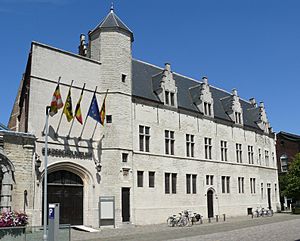
In 1482, Margaret faced a great sadness. Her step-daughter, Mary, died after falling from her horse. Mary's death weakened Burgundy even more. The people of Burgundy were tired of war. They did not want Maximilian to rule as regent for his young son, Philip.
They forced Maximilian to sign the Treaty of Arras with Louis XI. This treaty gave parts of Burgundy to France. Margaret could not get help from Edward IV, who had made peace with France. So, she and Maximilian had to accept the treaty. Maximilian's daughter, Margaret, was sent to the French court to be raised, taking more land with her as a dowry.
Problems continued for Margaret and Maximilian. In 1488, Maximilian was taken prisoner by the citizens of Bruges. Margaret called on the Emperor for help, and Maximilian was eventually released. The next year, Maximilian returned to Austria. Margaret was left to govern Burgundy with the Burgundian Estates and care for young Duke Philip.
She later welcomed her godchild, Margaret of Austria, back to Mechelen after the French court rejected her. Margaret of York's home in Mechelen became a royal court. Philip the Fair's children were also educated there. Margaret of York served as a model for later female governors.
Margaret also faced personal tragedies. Her brother, the Duke of Clarence, was executed in 1478. Edward IV died in 1483. Her younger brother, Richard III, was killed in battle in 1485. With Richard's death, the House of York no longer ruled England.
Margaret strongly supported anyone who challenged the new King, Henry Tudor. She backed two men, Lambert Simnel and Perkin Warbeck, who claimed to be her nephews and rightful heirs to the English throne. She even said Warbeck was her nephew, the younger son of Edward IV. She gave him money to try and take the throne in 1495. Warbeck failed and was later executed by Henry VII. Henry VII found Margaret very troublesome, but he could not harm her because she was protected by Maximilian.
Margaret died on November 23, 1503, at the age of 57. She was buried in the Church of the Cordeliers in Mechelen.
Legacy and Personal Life

Margaret was a patron of William Caxton, who brought the art of printing to England. A special copy of Recuyell of the Historyes of Troye, the first book printed in English, shows Caxton giving the book to Margaret. This book is now in the Huntington Library in California.
Margaret also ordered many beautiful illuminated manuscripts. One famous example is The Visions of Tondal, illustrated by Simon Marmion. It is now in the Getty Museum.
Margaret was a good-looking woman. She was very tall, almost 6 feet, and slim. She had gray eyes and a small mouth. Her smile showed her cleverness and kindness. She was very different from her husband, Charles the Bold, who was shorter and stockier. When they first met, she had to bend down to receive his kiss. Margaret was very intelligent and had a strong will. She was a worthy wife for the Duke.
She got along very well with her husband's family. She was like a mother to her step-daughter, Mary. Mary and Margaret shared interests in reading, riding, and hunting. Her mother-in-law, Isabella of Portugal, was very pleased with Margaret.
Margaret was a capable ruler and a masterful Duchess. She was loyal to her family, the Yorks, but she was first and foremost the Duchess of Burgundy. She did not have a male heir for Burgundy, but she helped save the state from ruin. Her actions helped Burgundy survive and prevented France from dominating Europe.
In Movies and Games
Margaret is a main character in the 2008 novel A Daughter of York by Anne Easter Smith. She also appears in Easter Smith's 2009 book The King's Grace.
In the video game Assassin's Creed: Brotherhood, there is a mission in London where Margaret is killed for King Henry VII.
She has been played by different actresses in TV dramas:
- Rachel Kempson in the 1972 BBC drama The Shadow of the Tower.
- Joanne Whalley in the 2017 Starz drama The White Princess.
- Alix Poisson in the 2017 German-Austrian TV series Maximilian.
See also
 In Spanish: Margarita de York para niños
In Spanish: Margarita de York para niños


